brake YAMAHA BANSHEE 350 2004 Owner's Guide
[x] Cancel search | Manufacturer: YAMAHA, Model Year: 2004, Model line: BANSHEE 350, Model: YAMAHA BANSHEE 350 2004Pages: 396, PDF Size: 3.55 MB
Page 320 of 396
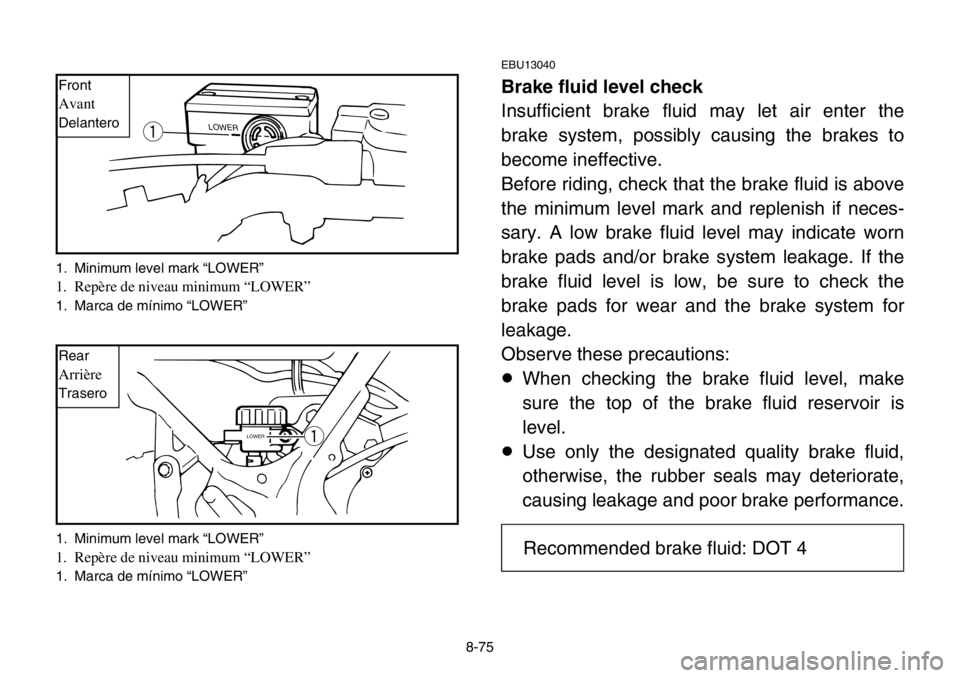
8-75
EBU13040
Brake fluid level check
Insufficient brake fluid may let air enter the
brake system, possibly causing the brakes to
become ineffective.
Before riding, check that the brake fluid is above
the minimum level mark and replenish if neces-
sary. A low brake fluid level may indicate worn
brake pads and/or brake system leakage. If the
brake fluid level is low, be sure to check the
brake pads for wear and the brake system for
leakage.
Observe these precautions:
8When checking the brake fluid level, make
sure the top of the brake fluid reservoir is
level.
8Use only the designated quality brake fluid,
otherwise, the rubber seals may deteriorate,
causing leakage and poor brake performance.
LOWERq
LOWERq
1. Minimum level mark “LOWER”
1. Repère de niveau minimum “LOWER”
1. Marca de mínimo “LOWER”
1. Minimum level mark “LOWER”
1. Repère de niveau minimum “LOWER”
1. Marca de mínimo “LOWER”Front
Avant
Delantero
Rear
Arrière
Trasero
Recommended brake fluid: DOT 4
Page 322 of 396

8-77
8Refill with the same type of brake fluid. Mixing
fluids may result in a harmful chemical reac-
tion and lead to poor brake performance.
8Be careful that water does not enter the brake
fluid reservoir when refilling. Water will signifi-
cantly lower the boiling point of the fluid and
may result in vapor lock.
8Brake fluid may deteriorate painted surfaces
or plastic parts. Always clean up spilled fluid
immediately.
8Have a Yamaha dealer check the cause if the
brake fluid level goes down.
Page 324 of 396

8-79
EEBU11860
Brake fluid replacement
Complete fluid replacement should be done
only by trained Yamaha service personnel.
Have a Yamaha dealer replace the following
components during periodic maintenance or
when they are damaged or leaking.
8Replace the oil seals every two years.
8Replace the brake hoses every four years.
Page 326 of 396
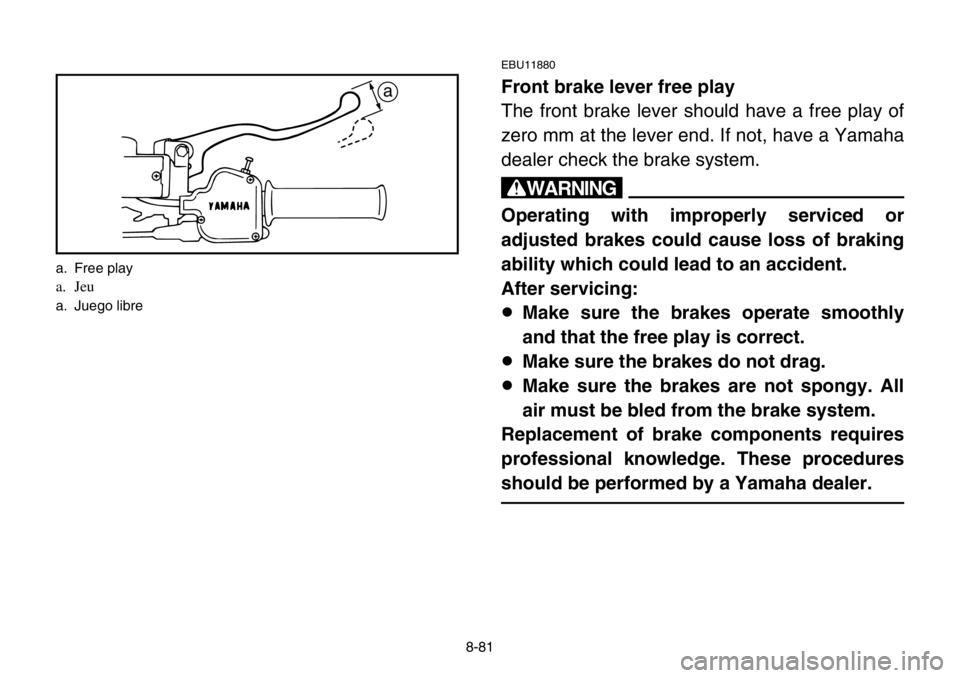
8-81
EBU11880
Front brake lever free play
The front brake lever should have a free play of
zero mm at the lever end. If not, have a Yamaha
dealer check the brake system.
w
Operating with improperly serviced or
adjusted brakes could cause loss of braking
ability which could lead to an accident.
After servicing:
8Make sure the brakes operate smoothly
and that the free play is correct.
8Make sure the brakes do not drag.
8Make sure the brakes are not spongy. All
air must be bled from the brake system.
Replacement of brake components requires
professional knowledge. These procedures
should be performed by a Yamaha dealer.
a
a. Free play
a. Jeu
a. Juego libre
Page 328 of 396
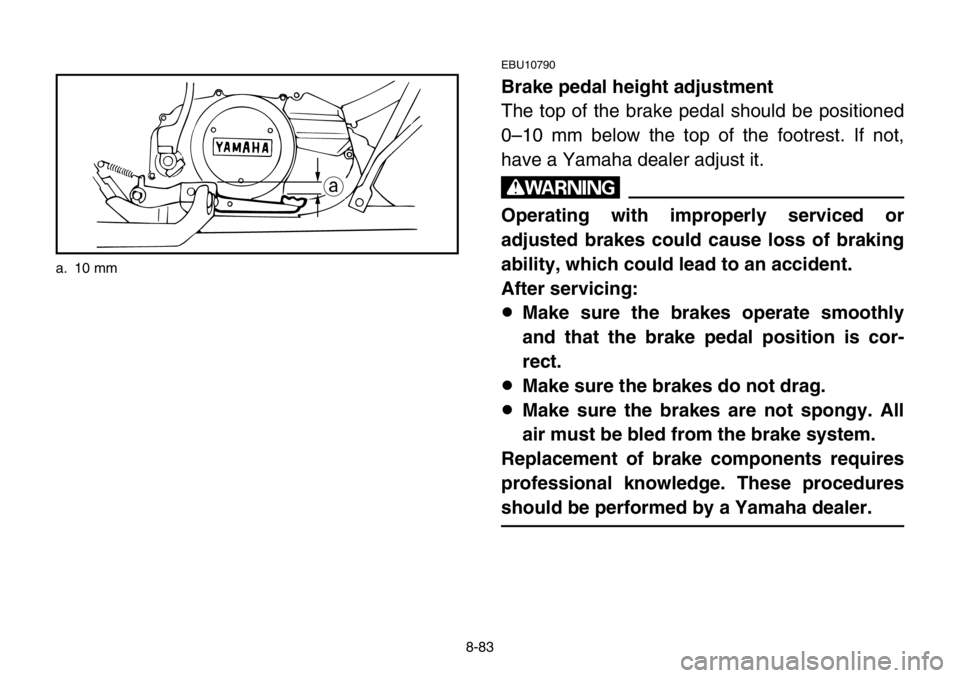
8-83
EBU10790
Brake pedal height adjustment
The top of the brake pedal should be positioned
0–10 mm below the top of the footrest. If not,
have a Yamaha dealer adjust it.
w
Operating with improperly serviced or
adjusted brakes could cause loss of braking
ability, which could lead to an accident.
After servicing:
8Make sure the brakes operate smoothly
and that the brake pedal position is cor-
rect.
8Make sure the brakes do not drag.
8Make sure the brakes are not spongy. All
air must be bled from the brake system.
Replacement of brake components requires
professional knowledge. These procedures
should be performed by a Yamaha dealer.
a
a. 10 mm
Page 330 of 396
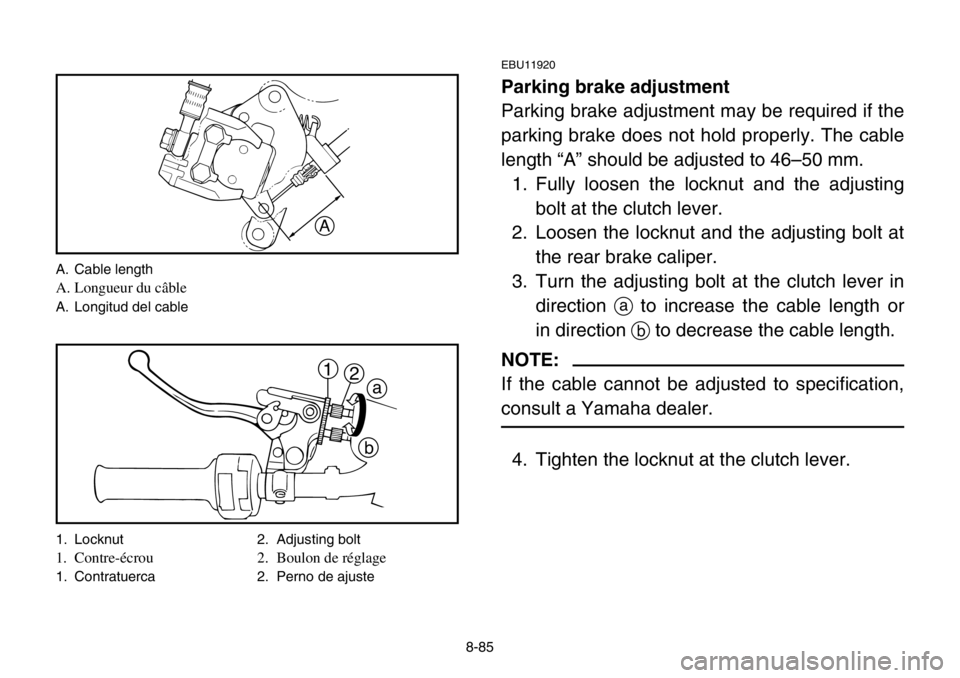
8-85
EBU11920
Parking brake adjustment
Parking brake adjustment may be required if the
parking brake does not hold properly. The cable
length “A” should be adjusted to 46–50 mm.
1. Fully loosen the locknut and the adjusting
bolt at the clutch lever.
2. Loosen the locknut and the adjusting bolt at
the rear brake caliper.
3. Turn the adjusting bolt at the clutch lever in
directionato increase the cable length or
in direction bto decrease the cable length.
NOTE:
If the cable cannot be adjusted to specification,
consult a Yamaha dealer.
4. Tighten the locknut at the clutch lever.
A
a
b 1
2
A. Cable length
A. Longueur du câble
A. Longitud del cable
1. Locknut 2. Adjusting bolt
1. Contre-écrou 2. Boulon de réglage
1. Contratuerca 2. Perno de ajuste
Page 332 of 396
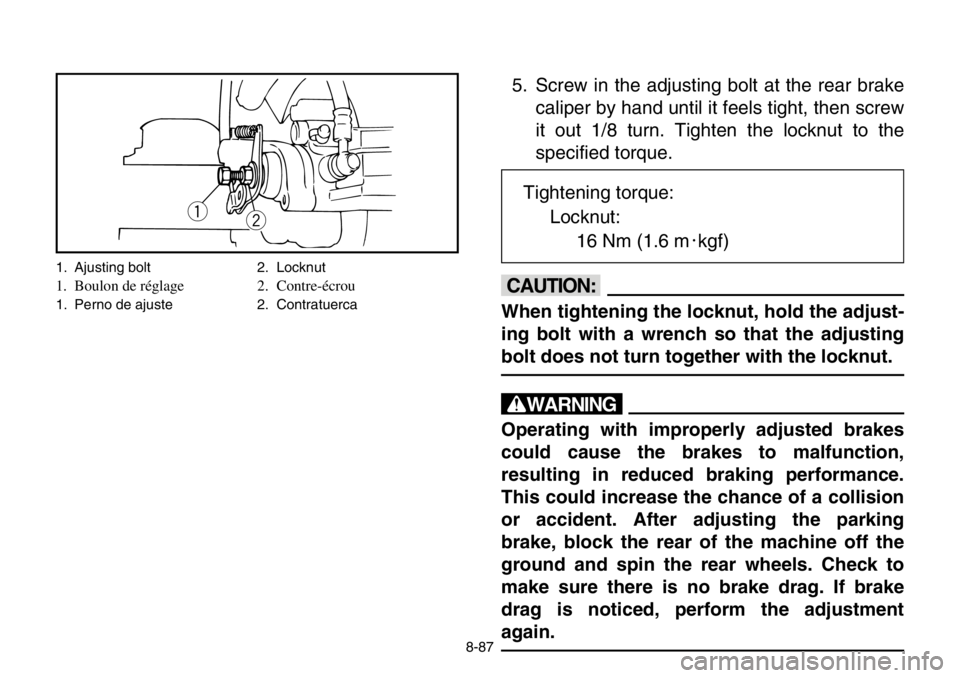
8-87
5. Screw in the adjusting bolt at the rear brake
caliper by hand until it feels tight, then screw
it out 1/8 turn. Tighten the locknut to the
specified torque.
cC
When tightening the locknut, hold the adjust-
ing bolt with a wrench so that the adjusting
bolt does not turn together with the locknut.
w
Operating with improperly adjusted brakes
could cause the brakes to malfunction,
resulting in reduced braking performance.
This could increase the chance of a collision
or accident. After adjusting the parking
brake, block the rear of the machine off the
ground and spin the rear wheels. Check to
make sure there is no brake drag. If brake
drag is noticed, perform the adjustment
again.
qw
1. Ajusting bolt 2. Locknut
1. Boulon de réglage 2. Contre-écrou
1. Perno de ajuste 2. Contratuerca
Tightening torque:
Locknut:
16 Nm (1.6 m0kgf)
Page 334 of 396
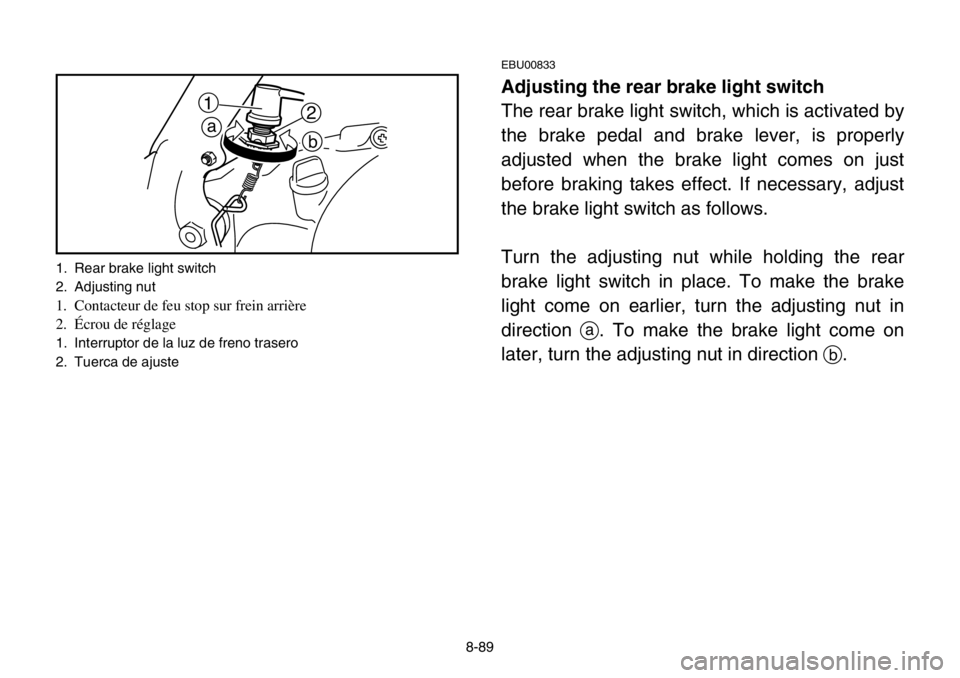
8-89
EBU00833
Adjusting the rear brake light switch
The rear brake light switch, which is activated by
the brake pedal and brake lever, is properly
adjusted when the brake light comes on just
before braking takes effect. If necessary, adjust
the brake light switch as follows.
Turn the adjusting nut while holding the rear
brake light switch in place. To make the brake
light come on earlier, turn the adjusting nut in
directiona. To make the brake light come on
later, turn the adjusting nut in direction b.1
2
a
b
1. Rear brake light switch
2. Adjusting nut
1. Contacteur de feu stop sur frein arrière
2. Écrou de réglage
1. Interruptor de la luz de freno trasero
2. Tuerca de ajuste
Page 346 of 396
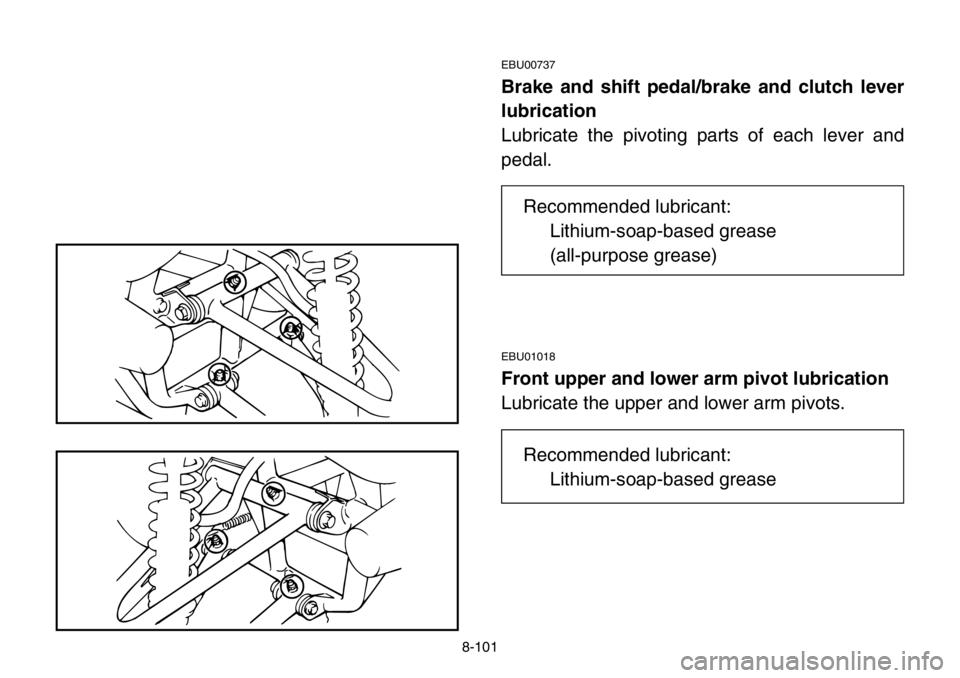
8-101
EBU00737
Brake and shift pedal/brake and clutch lever
lubrication
Lubricate the pivoting parts of each lever and
pedal.
EBU01018
Front upper and lower arm pivot lubrication
Lubricate the upper and lower arm pivots.
Recommended lubricant:
Lithium-soap-based grease
Recommended lubricant:
Lithium-soap-based grease
(all-purpose grease)
Page 356 of 396
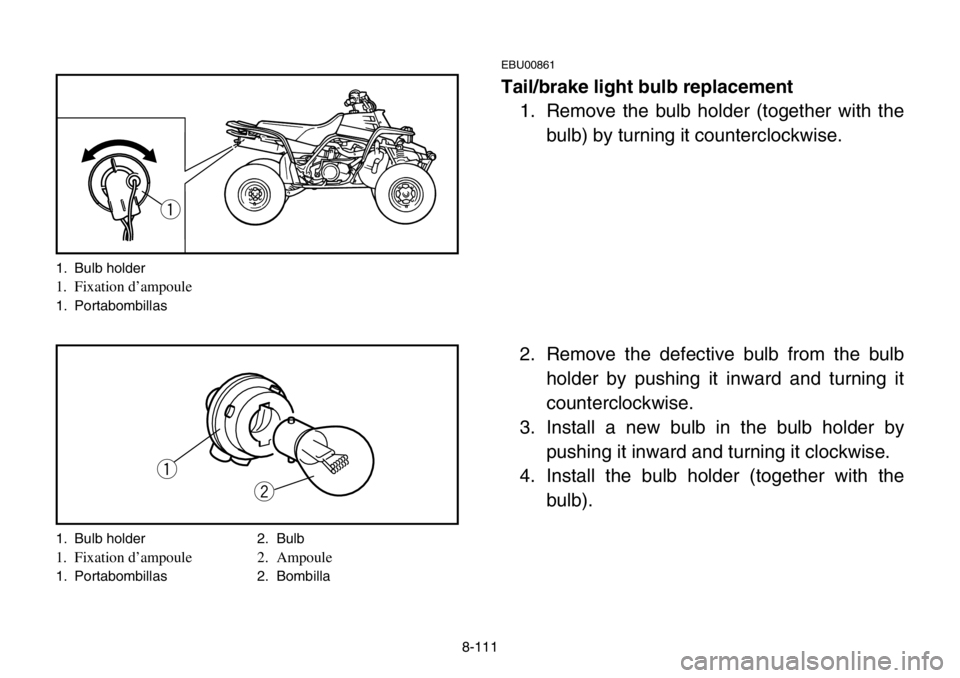
8-111
EBU00861
Tail/brake light bulb replacement
1. Remove the bulb holder (together with the
bulb) by turning it counterclockwise.
2. Remove the defective bulb from the bulb
holder by pushing it inward and turning it
counterclockwise.
3. Install a new bulb in the bulb holder by
pushing it inward and turning it clockwise.
4. Install the bulb holder (together with the
bulb).
q
q
w
1. Bulb holder
1. Fixation d’ampoule
1. Portabombillas
1. Bulb holder 2. Bulb
1. Fixation d’ampoule 2. Ampoule
1. Portabombillas 2. Bombilla